
Port Phillip or Port Phillip Bay is a horsehead-shaped enclosed bay on the central coast of southern Victoria, Australia. The bay opens into the Bass Strait via a short, narrow channel known as The Rip, and is completely surrounded by localities of Victoria's two largest cities — metropolitan Greater Melbourne in the bay's main eastern portion north of the Mornington Peninsula, and the city of Greater Geelong in the much smaller western portion north of the Bellarine Peninsula. Geographically, the bay covers 1,930 km2 (750 sq mi) and the shore stretches roughly 264 km (164 mi), with the volume of water around 25 km3 (6.0 cu mi). Most of the bay is navigable, although it is extremely shallow for its size — the deepest portion is only 24 m (79 ft) and half the bay is shallower than 8 m (26 ft). Its waters and coast are home to seals, whales, dolphins, corals and many kinds of seabirds and migratory waders.

Searoad Ferries is an Australian company that operates a roll-on/roll-off vehicle and passenger ferry service between the heads of Port Phillip, near Melbourne, Victoria, Australia.

Queenscliff is a town at the south-eastern end of the Bellarine Peninsula in southern Victoria, Australia. It lies south of Swan Bay at the entrance to Port Phillip. It is the administrative centre for the Borough of Queenscliffe. At the 2021 census, Queenscliff had a population of 3,276.
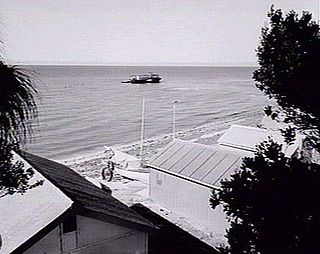
Indented Head is a small coastal township located on the Bellarine Peninsula, east of Geelong, in the Australian state of Victoria. The town lies on the coast of the Port Phillip bay between the towns of Portarlington and St Leonards.
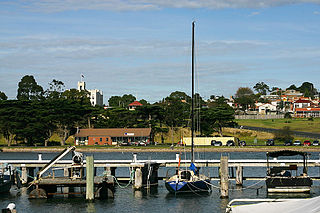
Portarlington is a town located on the Bellarine Peninsula, 28 km from the city of Geelong, in the state of Victoria, Australia. It has a diverse population which includes a wide range of ethnic backgrounds, a high proportion of retirees, and a large seasonal holiday influx. The gently rising hills behind the town feature vineyards and olive groves, and offer spectacular panoramic views across Port Phillip Bay. Portarlington is a popular family holiday destination and a centre of fishing and aquaculture (mussels). At one time the town claimed the largest Caravan Park in the Southern Hemisphere, although the size has reduced considerably in recent decades. With direct ferry links to the city of Melbourne Portarlington also serves as a gateway to the historic towns and surf beaches of the Bellarine Peninsula.
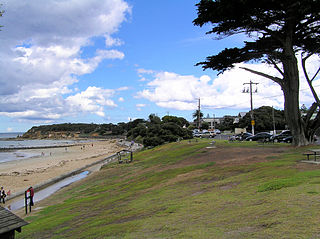
Point Lonsdale is a town on the Bellarine Peninsula, near Queenscliff, Victoria, Australia. The town is divided between the Borough of Queenscliffe and the City of Greater Geelong. Point Lonsdale is also one of the headlands which, with Point Nepean, frame The Rip, the entrance to Port Phillip. The headland is dominated by the Point Lonsdale Lighthouse. At the 2016 census, Point Lonsdale had a population of 2,684. The population grows rapidly over the summer months through to the Easter period due to its popularity as a holiday destination.

The Bellarine Peninsula is a peninsula located south-west of Melbourne in Victoria, Australia, surrounded by Port Phillip, Corio Bay and Bass Strait. The peninsula, together with the Mornington Peninsula, separates Port Phillip Bay from Bass Strait. The peninsula itself was originally occupied by Indigenous Australian clans of the Wadawurrung nation, prior to European settlement in the early 19th century. Early European settlements were initially centred on wheat and grain agriculture, before the area became a popular tourist destination with most visitors arriving by paddle steamer on Port Phillip in the late 19th century.
The 30-ton sloop Rebecca was launched in 1834, built by Captain George Plummer at his boatyard on the banks of the Tamar River at Rosevears, Van Diemen's Land (Tasmania).
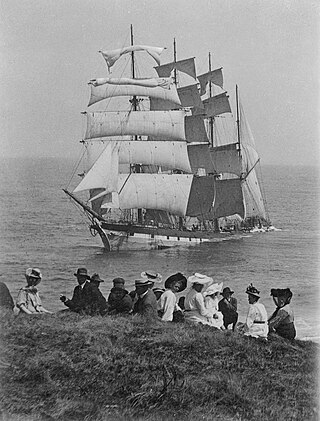
Falls of Halladale was a four-masted iron-hulled barque, built at Greenock in Scotland in 1886 for the Falls Line of Glasgow. She was operated in the long-distance trading of bulk cargos. On 14 November 1908, she was wrecked on the Australian coast near Peterborough, Victoria, due to the negligence of the captain.
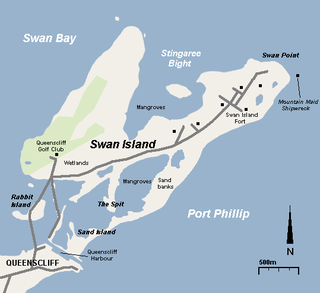
Swan Island is a 1.4 km2 sand barrier island which, with Duck Island and the Edwards Point spit, separate Swan Bay from Port Phillip in Victoria, Australia. It lies close to and north of the town of Queenscliff at the eastern end of the Bellarine Peninsula, and is an official bounded locality of the Borough of Queenscliffe.

Fort Queenscliff, in Victoria, Australia, dates from 1860 when an open battery was constructed on Shortland's Bluff to defend the entrance to Port Phillip. The Fort, which underwent major redevelopment in the late 1870s and 1880s, became the headquarters for an extensive chain of forts around Port Phillip Heads. Its garrison included volunteer artillery, engineers, infantry and naval militia, and it was manned as a coastal defence installation continuously from 1883 to 1946. The other fortifications and armaments around the Heads were completed by 1891, and together made Port Phillip one of the most heavily defended harbours in the British Empire.
SS Cheviot was an iron screw steamer built by Charles Mitchell and Co., of Low Walker, Newcastle upon Tyne, England in 1870. She was owned by Wm. Howard Smith & Sons, Melbourne, Australia, for the transportation of coal and passengers. In 1887, she was wrecked in rough seas near Point Nepean in Victoria, Australia, with the loss of 35 lives, after the propeller was disabled. The beach nearby was subsequently named Cheviot Beach.

SS City of Launceston was a 368 GRT steamship operated by the Launceston and Melbourne Steam Navigation Company from 1863, which had an early role in colonial steam shipping as the forerunner of the modern Bass Strait ferry service between Tasmania and Victoria. It was sunk in Port Phillip Bay after a collision with another ship on 19 November 1865.

Fort Nepean is a former defensive facility occupying part of Point Nepean, Victoria, Australia. It was part of a network of fortifications, commanded from Fort Queenscliff, protecting the narrow entrance to Port Phillip. It is now part of Point Nepean National Park and a local tourist attraction.
Jack Kenneth Loney was an amateur Australian maritime historian who published over one hundred books and numerous newspaper and magazine articles. He was a schoolteacher and principal until his retirement. He became interested in maritime history after preparing several general history booklets covering the Otway region of western Victoria, Australia.

HMAS Goorangai was a 223-ton auxiliary minesweeper of the Royal Australian Navy (RAN). She was built in 1919 for the Government of New South Wales, then sold in 1926 to the fishing company Cam & Sons. The trawler was requisitioned for military service following the outbreak of World War II, converted into a minesweeper, and assigned to Melbourne. She was sunk in an accidental collision with MV Duntroon in 1940, becoming the RAN's first loss of World War II, and the first RAN surface ship to be lost in wartime.
HMVS Lonsdale was a second-class torpedo boat constructed for the Victorian Naval Forces and later operated by the Commonwealth Naval Forces and the Royal Australian Navy. She was sunk on mud flats on Swan Island in Port Phillip Bay in 1912 after being stripped of equipment and machinery. Having been commissioned in 1884, and then officially joining the Commonwealth Naval forces in 1901, the boat was the oldest ship in the Royal Navy, and is the oldest Royal Australian Navy ship still in existence.

The paddle steamer PS Weeroona was built by A. & J. Inglis, Pointhouse, Glasgow, Scotland and launched in 1910. It was initially owned by Huddart Parker Ltd, Melbourne. During World War II, the ship was requisitioned for wartime service and used by the United States Army as a barracks and quarters ship through the war.
William Salthouse was the first merchant vessel to sail with a cargo of merchandise from the British Dominion of Canada to British Colonies of Australia. The ship was lost on 28 November 1841 while attempting to enter Port Phillip Heads en route to Melbourne Harbor. The wreck of William Salthouse has been the site of several maritime archaeological investigations as well as experimental in situ conservation efforts.
Clonmel was a three-masted wooden paddle steamer built in Birkenhead, England, in 1836. Clonmel was one of the first steam-powered vessels on the Australian coast. It ran aground in the early hours of 2 January 1841, or the 3rd. and was wrecked on what is now known as Clonmel Island in Corner Inlet, Victoria. This was only its second voyage from Sydney.


















